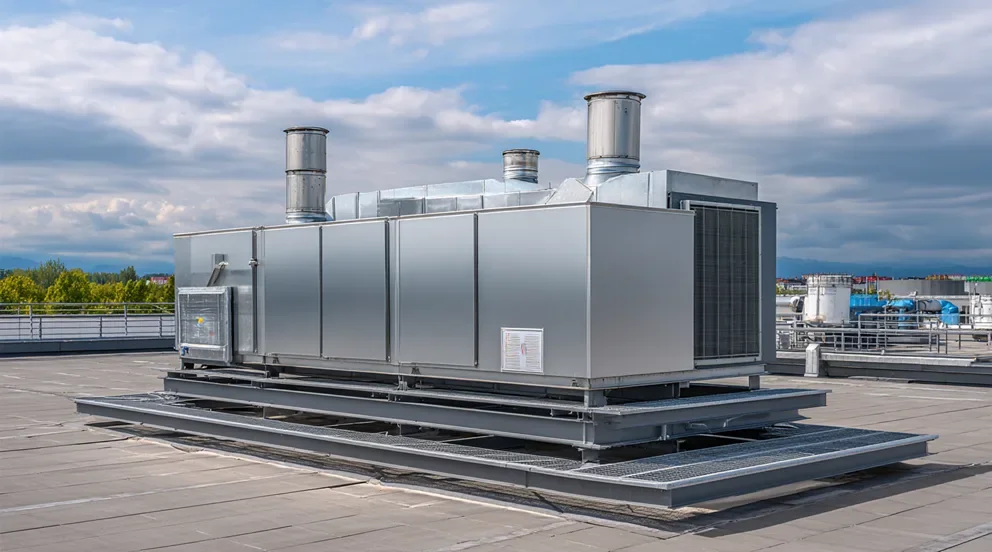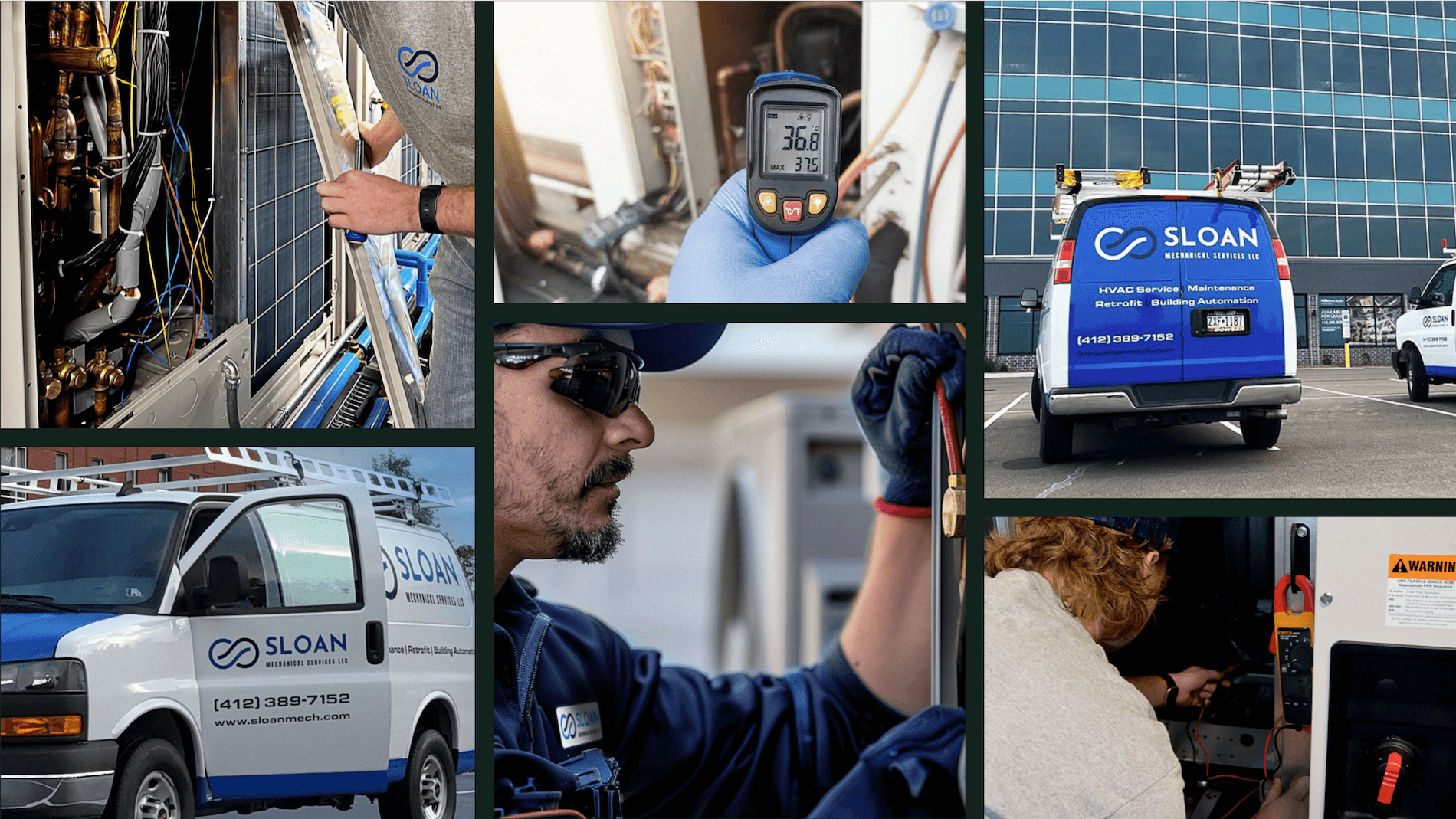Working in the HVAC industry can be complicated enough, but even more so is running an HVAC business. You don’t just have to set guidelines for what techs do in the field. You also have to lay down rules for how things should be done in the back office and how employees should act when they’re off-duty.
A good place to start in organizing all these regulations and instructions is to write them down in an HVAC policy and procedure manual. This gives all employees an accessible reference point for all of your company’s standards, best practices, and codes of conduct. In this article, we’ll dive into why and how to build this kind of manual, including:
- 6 benefits of developing a thorough HVAC policy and procedure manual
- 5 types of HVAC manuals for policy & procedure development
- 30 essential components to include in every HVAC employee handbook
- 5 best HVAC manual examples to base your employee guides on
- How to write an HVAC policy and procedure manual
- 4 critical FAQs that will help you write a better HVAC manual
We’ll begin with some reasons for why you should put together as thorough of an HVAC manual as you can.
6 benefits of developing a thorough HVAC policy and procedure manual
There are upsides to building a comprehensive handbook for your HVAC company besides serving as an accessible reference point for your policies & procedures, and these are the top benefits:
- Increase efficiency with the latest technology and techniques – The latest technological HVAC advancements, work methods, and designs can tighten temperature control, manage air quality better, increase energy efficiency, and reduce environmental impact.Your HVAC manual should include what they are and how they work so employees know how to get the most out of them.
- Give clear instructions to maintenance staff – You can reduce downtime, minimize errors, and help an HVAC system last longer if the techs who maintain it know exactly what to do for routine checks, repairs, and troubleshooting.
- Train new employees more effectively – A thorough manual makes it easier to train new maintenance employees and get them up to speed quicker on what they need to do.
- Protect employees and assets – Having comprehensive safety protocols helps to reduce accidents and prevent costly damage to HVAC units and buildings, especially in an emergency.
- Save your customers’ money – Optimized HVAC systems run longer and don’t use as much energy. This helps customers save money by lowering their utility bills and preserving equipment warranties, which they’ll appreciate.
- Comply with legal requirements – The HVAC industry is regulated at the local, state, and federal levels, so the manual’s contents should be in line with the latest safety, environmental, and other industry standards. This helps you avoid non-compliance and the associated costs (fines, legal fees, and so on).
5 types of HVAC manuals for policy & procedure development
Different types of HVAC handbooks are written for different purposes. Therefore, you may need more than one type of HVAC manual to cover all of your policies and procedures, or a unified manual that incorporates some or all of these concepts.
- Procedures & Forms – A manual that outlines how to do various HVAC tasks, often providing charts and formulas as aids. It also includes blank forms that you can copy and fill in as worksheets and reports, sometimes also giving examples.
- Safety Manuals – Manuals that discuss potential safety hazards in an HVAC workplace. They also include directions on how to prevent said hazards from causing accidents, injuries, and other dangerous situations.
- Employee Handbooks – Manuals designed to help HVAC employees get familiar with a company’s operations, culture, and rules. They lay out an employee’s rights and responsibilities when working with the company.
- Design Manuals – Manuals that explain the principles and methods behind designing HVAC systems. They cover things like how to plan ductwork, fit pipes, program control systems, select the right parts, calculate heating & cooling loads, and meet all relevant construction regulations.
- Software-Integrated Checklist – This is a component of some HVAC management software programs that allows for building custom digital checklists. While not technically a policy & procedure manual, it can help to make sure employees follow a company’s policies & procedures. For example, it can make certain tasks at a worksite mandatory to complete and report on before a tech can submit a full field report, generate an invoice, and so on.
30 essential components to include in every HVAC employee handbook
It’s easier to think about what you should specifically put in an HVAC employee handbook if you organize things into categories covering different parts of your company’s operations. We’ve provided an example below, along with points that are critical to cover in your manual.
Intro and statements
These are general items that explain the handbook’s purpose and overall HVAC company conduct. They include the company’s policies on hiring, training, and retaining employees, and also overall employee responsibilities.
- Introduction & mission statement – Gives an overview of the purpose of the manual in helping employees install and maintain HVAC systems that function well while saving energy.
- Responsibilities of each employee role – Defines specifically how each staff position contributes to managing an HVAC system. This keeps employees accountable and prevents roles from overlapping.
- New staff policy – Outlines the procedures for hiring and training new staff.
- Professional development policy – Sets guidelines for continuously training staff, including teaching them about the latest HVAC technologies and standards, to keep them performing well.
- Safety policy statement – Gives a general summary of how employees are expected to act to maintain a safe work environment.
- Employee acknowledgement – Usually put at the end of the manual, it lets an employee confirm they’ve read the manual and agree to its policies.
Sections covering general safety
These are items related to safety issues common to workplaces across different industries.
- Incident response plan – Sets general procedures for dealing with accidents, injuries, and other emergencies in the workplace. These should include how to give first aid and how to report what happened.
- Emergency action plan by issue – Details specific procedures to follow in the event of particular types of emergencies, such as fire, chemical spills, or natural disasters. They should include information such as evacuation routes and meeting points.
- Ergonomics – Explains proper posture when working, and how to correctly use equipment, to avoid minor (but preventable) workplace injuries such as back pain or carpal tunnel syndrome.
- Slip & fall – Directions on how to tidy up a work area and use proper safety equipment to avoid employees tripping, slipping, or falling.
- Emergency contacts – Summarizes contact information for people and organizations who are to be contacted in an emergency, helping to reduce response times and minimize damage or hazards caused by equipment downtime.
- OSHA – References relevant Occupational Safety and Health Administration regulations, and how employees should act in the workplace to stay compliant with these rules.
HVAC-specific safety protocols
These are safety items related to unique hazards HVAC techs may encounter at a workplace.
- Environmental hazards – Lays out general safety procedures regarding objects, substances, weather, etc. commonly encountered at a work site that potentially pose hazards to HVAC techs.
- Biological exposure – Instructs techs on how to deal with mold, bacteria, and other potentially harmful organisms they may find within an HVAC system. It should include procedures for sanitizing contaminated areas and a list of protective equipment techs should use or wear when dealing with different substances.
- Tools – Explains how to properly use hand tools and power tools, both common and specific to HVAC jobs.
- Ladders – Briefs techs on safety rules for using ladders, including inspecting for hazardous defects, correct positioning for proper support, and limiting load weights to prevent collapses.
- Heavy lifting – Describes the proper procedures to avoid injuries when lifting heavy objects, including using lifting aids or lifting with multiple people.
- PPE – Lists personal protective equipment that may be needed for various HVAC tasks, along with instructions on how and why to use it.
- Forklit / aerial lift – Notes how to safely operate forklifts or aerial lifts, including training requirements and inspection best practices.
- Soldering / gas / oxygen – Spells out safety directions for soldering if you need to do it for an HVAC task. These should include properly ventilating the surrounding area, wearing a respirator, and having an external oxygen supply if necessary.
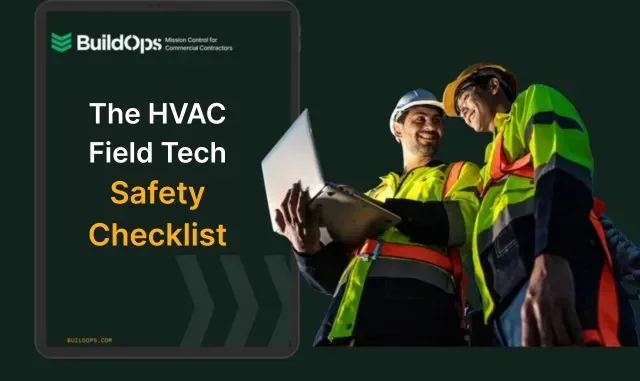
Get the HVAC Safety Checklist
See how HVAC teams can stay compliant and keep communications secure.
Non-safety HVAC policies and procedures
These items cover administrative policies and general best practices for HVAC work.
- Record keeping & field reports – Dictates how the company will record and store information on work, in either the field or office, for future reference and legal compliance. May also include directions on how to use a field service report app if the company is using one.
- How customer documentation is stored – Discusses how the company will maintain privacy and security for customer data, including procedures for storing, accessing, and handling that data. May also include instructions for using any HVAC CRM software used by the company.
- Cybersecurity – Outlines how the company will secure its IT infrastructure against cyberattacks and other digital threats. This item should also include what to do if the company suffers a data breach.
- Maintenance schedules – Provides guidelines on setting maintenance schedules for HVAC systems and instructions on common maintenance tasks such as equipment checks, filter changes, and system inspections. If the company uses HVAC scheduling software, this section may also teach how to use it.
- Troubleshooting errors – Advises on how to solve common HVAC system problems, including how to diagnose them and what repair steps to take.
- Environmental – States your HVAC company’s policies on environmental sustainability, including on responsible energy consumption and on safe disposal of substances that are harmful to the environment.
- Climate control – Summarizes best practices for adjusting and maintaining HVAC systems to meet customer climate needs while remaining energy-efficient.
- Energy efficiency – Covers best practices for optimizing energy use in both running and maintaining HVAC systems. These can include making certain system adjustments, using advanced equipment, or suggesting system upgrades to customers.
- Load calculation – Instructs HVAC techs on how to calculate heating and cooling loads for buildings, guaranteeing that an HVAC system is the proper size for a building and is as energy-efficient as possible.
- Design – Lays out standards and processes for designing HVAC systems, including needed materials, ductwork layouts, compliance with building codes, and how each part of the system integrates with the others.
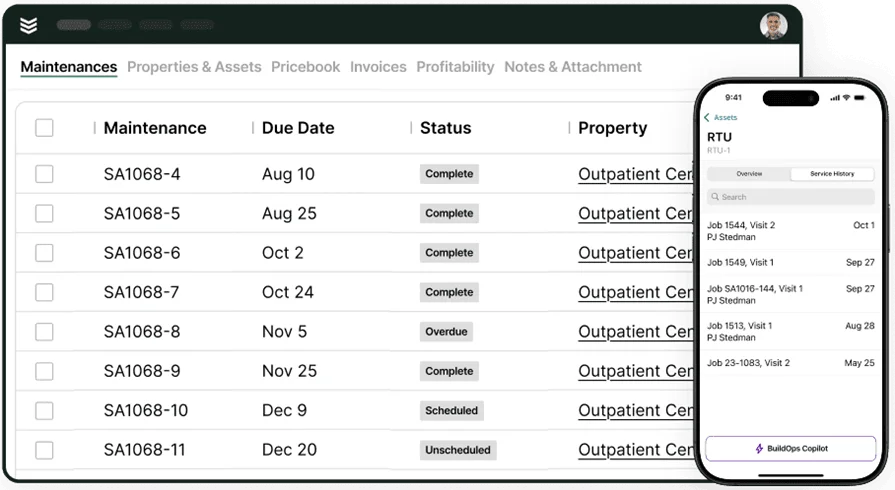
Explore our commercial HVAC tool
We help HVAC professionals manage large scale projects with ease.
5 best HVAC manual examples to base your employee guides on
Your company should have at least the first 4 types of manuals we listed (and really should have the 5th!), either separately or as part of one or more unified HVAC business operations manuals. To help you put them together, we’ve provided standout examples of each type so you know what each one should roughly look like.
1. HVAC procedures & forms manual example: HVAC Procedures and Forms Manual – Second Edition
Image Source: Gorman Industries
This manual by Herbert Wendes provides a quick reference for procedures, and formulas for tasks related to five major task groups in HVAC: testing & balancing, energy auditing, indoor air quality, load calculations, and cost estimating. It also includes charts as visual aids and worksheets – with examples – for writing your own reports.
Standout Section You’ll Want To Copy: The second edition of this manual includes an additional chapter that outlines a detailed problem-solving process for various issues commonly encountered by HVAC contractors and engineers.
Get HVAC Procedures and Forms – Second Edition by Herbert Wendes here.
2. HVAC safety manual example: CompSource Mutual Sample HVAC Safety Manual
Image Source: CompSource Mutual
A sample HVAC safety manual written by an insurance company. It includes an incident response plan, emergency action plans for certain hazards, general safety policies, and safety guidance for particular elements of the workplace (slips/trips/falls, ladders, extreme temperatures, hazardous substances, PPE, and so on). It also contains an employee acknowledgment at the end where an employee can sign off on having read, understood, and ac
Standout Section You’ll Want To Copy: The “Safety is a Team Effort” section lays out the overall responsibilities that managers, supervisors, and employees have in creating a safe workplace.
Use the CompSource Mutual Sample HVAC Safety Manual as a template for your own company’s safety policies and procedures.
3. HVAC employee handbook example: Jacob Heating & Air Conditioning Employee Handbook
Image Source: Jacob HAC
An employee handbook that begins with a message from the company president, and then some brief background information about the company. It then goes through sections one by one on topics related to employment terms, employee data handling, time off policies, employee benefits, payroll, safety, workplace conduct, and discipline.
Standout Section You’ll Want To Copy: Since vehicles are vital but expensive assets for field service companies, the handbook requires an employee’s signature for its policies on both maintaining and driving company-supplied vehicles.
Have a look at the Jacob Heating & Air Conditioning Employee Handbook for ideas on how to write your own handbook.
4. HVAC design manual example: U.S. Department of Veterans Affairs HVAC Design Manual
Image Source: U.S. Department of Veterans Affairs
This manual outlines the HVAC system design standards for U.S. Department of Veterans Affairs healthcare facilities, covering energy efficiency, measurement, and VA building codes. It details the design and component selection for air conditioning, heating & cooling, and control systems, provides specifications for different room types, and includes climate data for HVAC installation and maintenance considerations across the U.S.
Standout Section You’ll Want To Copy: One of the chapters includes average climate statistics for different places in the U.S., which can affect how HVAC systems are designed for those climates (for example, places with hot and humid climates need HVAC systems that can handle increased energy consumption and will be resilient against wear and tear).
See how the U.S. government designs HVAC systems for its facilities by downloading the Veterans Affairs HVAC Design Manual.
5. Software-integrated HVAC checklist example: BuildOps
Image Source: BuildOps
This feature in BuildOps allows you to integrate compliance with your policies and procedures right into your regular workflows. By creating checklists, you can require techs to fill in certain information before they can complete field reports, invoices, and other documentation.
You can also have the values entered in these checklists connect to other areas of your operations. This lets you fill in estimates, invoices, accounting records, analytics reports, and more automatically without having to enter the same information again in the back office.
Standout Section You’ll Want To Copy: You can require entering cost estimates in a checklist. These items can then integrate with your sales & financial functions to automatically create estimates, quotes, invoices, and more.
Don’t waste time having to constantly revise or rewrite paper manuals. Get a software solution that allows you to:
- Give employees access to your most current policies & procedures from virtually anywhere
- Instantly update policies & procedures across your entire company from a central hub
- Automate functions based on data your techs are required to enter by your policies & procedures
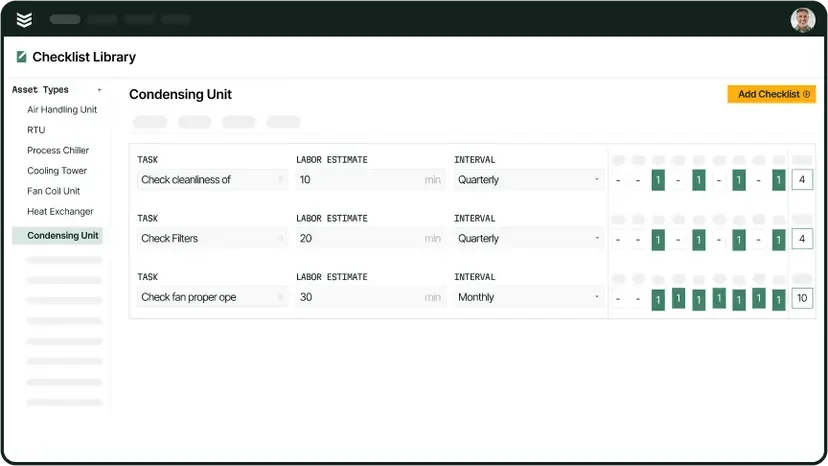
Curious to see how it works?
BuildOps helps HVAC contractors stay compliant while speeding up jobs.
How to write an HVAC policy and procedure manual
Now that we’ve covered what should be included in an HVAC principles and applications manual and what different types should look like, it’s time to put it all together. Here’s a step-by-step guide on how to craft and document your HVAC company’s policies & procedures so they work how you intend them to.
1. Identify the general policies and procedures you want to cover
Depending on the type of policy and procedure manual you want to write, you’ll be covering different topics. For example, a procedures & forms manual will include instructions for competing HVAC tasks and forms to fill in to report on work done. Meanwhile, an employee handbook will be less technical and focus on the HR side of your company: things like core values, employment policies, and codes of conduct.
Begin by determining the specific processes your manual will cover. These identified processes will form the foundation for more detailed HVAC policy and procedure development.
2. Add details to the processes
Once you have your main processes down, start filling in how employees should follow them. Use brief sentences and paragraphs with clear language to guarantee that guidelines aren’t confusing or open to being misinterpreted.
Break down multi-part processes into distinct, logical steps so it’s easier for the reader to digest the information and follow along. Also remember to add things like lists of necessary materials, lists of required tools & safety equipment and directions on how to use them (and notes on how to use HVAC inventory management software if you have it), and any other information that may be applicable to a particular task. That can include formulas for calculations your techs may need to make, or any other specific regulations they need to follow.
3. Account for variants and special situations
There are cases in which something can be done multiple ways, or needs to be handled in a specific way, depending on the circumstances. This is especially true for HVAC since it covers heating, ventilation, and air conditioning, and these systems may need to be installed, repaired, or replaced in combinations. Add in information about these unique scenarios where each one makes sense, either at the end of sections on specific processes or near instructions where they’re most applicable.
4. Review the contents
Have people familiar with the procedures outlined in the manual – such as experienced techs and managers – look over the draft for anything that’s missing, incorrect, or unclear. They want to guarantee that the language, especially the jargon, is simple enough that your techs can understand it regardless of their experience level. They should also assess whether the procedures and instructions apply to situations that employees could reasonably encounter in daily work.
5. Test the practicality of your policies and procedures
Your policies and procedures are only good if they give you the results you want. Check this by having your employees follow your policies & procedures in exercises that mimic real-world scenarios and everyday work. See what works and what doesn’t, and have employees provide feedback on what they liked and disliked about the rules they had to follow. You may find unexpected issues that affect how you form your rules & instructions, or at least make for extra exceptions where things need to be done differently depending on the situation.
Also make sure your policies are flexible enough that they allow your company to grow, and can scale with your company as it does so. On one hand, you don’t want your company to be so bogged down in red tape that you can’t be profitable and efficient. On the other hand, you have to anticipate what direction your company is going in and how far it’s likely to go. Your policies & procedures should still make sense even if you get a larger and more diverse client base and workforce. Read our data-driven guide to commercial HVAC growth for an idea of how much your HVAC company is likely to grow over the course of 2 years.
6. Revise any areas that need improvement and repeat the review cycle as necessary
Take the observations and feedback from the testing step and use them to rewrite any sections of your manual that need to be changed. Again, review your edits to check if they make sense, and test them to make sure they work in practical contexts. If you need to make further revisions, start this cycle again. Otherwise, you’re done!
7. Integrate key components into your HVAC field management software
We strongly recommend this extra step if your HVAC company uses field management software. By incorporating your policies & procedures into your HVAC field service software, you can make them accessible to all of your employees regardless of where they are. Plus, you can instantly update your policies & procedures from a centralized location – no need to revise or rewrite paper manuals for every one of your employees!
Some software even lets you implement your policies & procedures in your everyday workflows. For example, you could turn them into checklist items that your techs have to complete and cross off before they can finish their field reports and leave the job site. You could even connect those items to your other operations – sales, accounting, analytics, CRM, and more – to automate tasks without having to input the same information twice.
Deep Dive
If you don’t have an HVAC field management software system, or are considering getting a new one, read our HVAC software buying guide for information about costing and top features. We also give advice on picking the right option for your company and getting the most out of it.
4 critical FAQs that will help you write a better HVAC manual
Here are some other things you may want to know about writing HVAC operation and maintenance manuals and other handbooks.
1. What exactly is an HVAC policy and procedure manual?
An HVAC policy & procedure manual is a document (or one of a set of documents) that lays out the rules an HVAC company operates by and the proper methods techs should use to complete HVAC tasks. This can include:
- The roles of different positions
- How the company hires and trains employees
- The steps techs should take to do their HVAC work
- How techs can keep themselves safe in the workplace, and what they need to watch out for
- Standards to follow when taking measurements, setting schedules, and solving problems
- How employees should deal with customer inquiries, requests, and feedback
- How customer details and other administrative information are processed, stored, and protected
- Other environmental and industry-specific regulations the company has to follow
2. Who needs an HVAC policy and procedure manual?
All employees of an HVAC company should have the company’s policy & procedure manual, whether that means physical copies or access to a digital version (or both). Everyone in the company needs to understand what their responsibilities are, how to do their jobs properly, and how they’re expected to act towards customers and each other.
3. How often do you need to update your HVAC employee handbooks & manuals?
A general guideline is to update your HVAC customer service handbook and other manuals at least once a year. A lot can change in 365 days, so it’s good to review your handbooks and make additions (or deletions) where things have changed.
Ideally, though, you should update your handbooks more frequently to reflect significant changes both inside and outside your company. These can include:
- Your company merging with, acquiring, or being acquired by another company
- Creating new job roles, or changing the responsibilities of existing job roles
- New or altered benefits, and eligibility requirements for them
- Introducing new technologies to your company
- New technologies, equipment, or work techniques necessitating new safety guidelines
- Changes to your company’s performance standards
- Changes to employment law and other regulations
If your handbooks are integrated with an HVAC field service platform, you can make changes to them at the admin level and they will automatically update and sync for all of your employees at once!
4. Is the HVAC industry subject to regulations your manual needs to follow?
Yes. Your manual will need to include information and instructions on complying with US HVAC regulations and standards related to:
- Energy efficiency
- Refrigerant management
- Environmental impact (via EPA certification)
- Employment law
- Workplace safety and insurance
- Building codes such as the IRC and IMC
- State-specific requirements
- Local ordinances from cities and counties
Keeping track of your HVAC company’s policies and procedures is important, but it doesn’t have to be hard. Create your manuals on the BuildOps field service management system and you can update them for all employees at any time – no need to rewrite your manuals by hand or update your handbooks on separate devices.
Plus, you can use your policies and procedures to build software-integrated checklists that make sure your techs are following your guidelines while they’re out in the field. Even more, checklist items can be connected to other functions to automate things like invoicing!
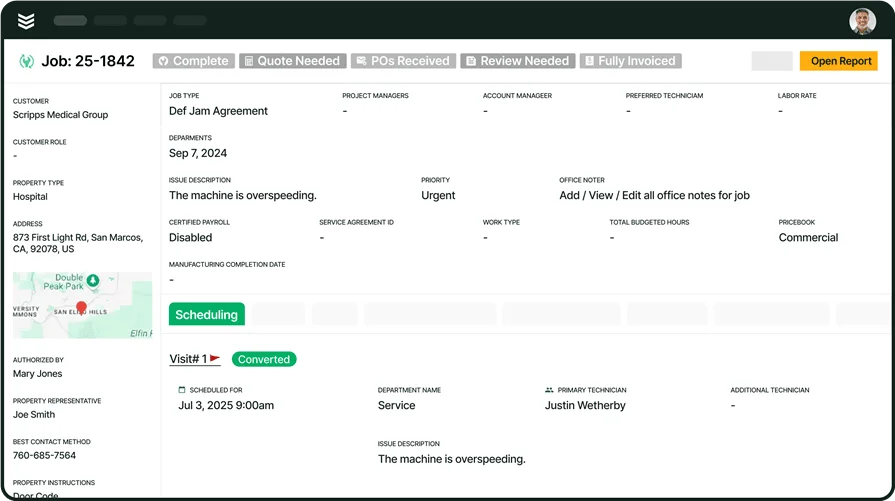
Take a closer look at BuildOps
We help HVAC pros streamline operations so they can get jobs done faster.



